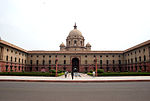Rashtrapati Bhavan Museum

Rashtrapati Bhavan Museum (ISO: Rāṣṭrapati Bhavana Saṁgrahālaya lit. 'Presidential Palace Museum') is a public biographical museum located on the Raisina hill of New Delhi dedicated to the presidents of India from its establishment as a republic to present day. It was established on 25 July 2014 by Pranab Mukherjee, who served as the president of India at the time. As the first underground museum of India, it was opened for the public on 24 July 2016. The museum contains artifacts and information surrounding the position of the president of India as well as the people who held the office. Aside from the presidents, it also displays information about the prime ministers of India, the establishment of New Delhi during the colonial rule, Delhi Durbar, the Indian independence movement, the partition of India and drafting of the Indian constitution. The museum uses tools like virtual and augmented reality, interactive digital cascading tables, video walls, three-dimensional stereoscopic projections, holographic projections, and sound-light-video synchronized stage settings to display information.
Excerpt from the Wikipedia article Rashtrapati Bhavan Museum (License: CC BY-SA 3.0, Authors, Images).Rashtrapati Bhavan Museum
Kartavya Path, New Delhi
Geographical coordinates (GPS) Address Phone number Website Nearby Places Show on map
Geographical coordinates (GPS)
| Latitude | Longitude |
|---|---|
| N 28.614444444444 ° | E 77.199722222222 ° |
Address
Rashtrapati Bhavan
Kartavya Path
110004 New Delhi (Chanakya Puri Tehsil)
Delhi, India
Open on Google Maps










